From critical malware attacks to accidental plugin deletions, unexpected events like these can be devasting for your website. That’s why you need to create a backup of your WordPress website.
By creating backups, you’re able to safeguard your website data from security threats and human errors. You can easily restore a saved version of your site in case anything goes wrong.
Over our years of managing countless websites, our team has relied on backups to recover from a variety of problems. We know firsthand how important it is to protect your hard work and prevent costly downtime.
In this article, we’ll show you how to back up your WordPress site.

Why Back Up Your WordPress Website?
As a WordPress website owner, you need to protect your data from unexpected events. Creating a website backup is one of the ways to protect your crucial data.
There are many security threats that can compromise your site and lead to data loss. For example, hackers, malware, and phishing attacks can leave your site’s data vulnerable.
Similarly, human errors, conflicts between WordPress plugins, themes, or server failures can break your site. If you’re unable to troubleshoot the issue, then it can be very difficult to recover your website.
A WordPress backup saves a copy of your site’s important files, folders, and databases. This includes your content, plugins, themes, images, videos, settings, and other information. You can easily use the backup to restore your website in case you get locked out of your website due to an error or cyberattack.
Do note that WordPress doesn’t offer a built-in option to automatically back up your WordPress site on a regular basis. You’d have to manually back up your site using the hosting service’s cPanel or an FTP client.
An easier way is to use a plugin, as you’ll have more control over which content to save. Plus, it is a beginner-friendly method, as accessing the cPanel or FTP client can be overwhelming for new users.
💡Need help managing your WordPress site? Let WPBeginner experts handle all WordPress technicalities. Backups, updates, security – we’ve got it covered. We keep your site running smoothly so you can spend your time on what truly matters.
That said, let’s see how you can create a WordPress backup using different methods. You can click the links to jump ahead to your preferred method:
Method 1: Backup a WordPress Site Using a Plugin (Recommended)
The easiest way to create backups is by using a plugin like Duplicator. It is the best WordPress backup plugin that’s used by over 1,500,000 professionals. Duplicator is a beginner-friendly plugin that makes it very easy to back up, migrate, and clone your website.
For this tutorial, we’ll be using the Duplicator Pro plugin because it includes more features like scheduled backups, recovery points, cloud storage integration, migration tool, and more. There is also a free version of Duplicator you can use to get started.
First, you’ll need to install and activate the Duplicator Pro plugin. If you need help, then please see our guide on how to install a WordPress plugin.
Upon activation, you can go to Duplicator Pro » Settings from your WordPress admin panel and switch to the ‘Licensing’ tab. Go ahead and enter the license key, which you can find in the account area.
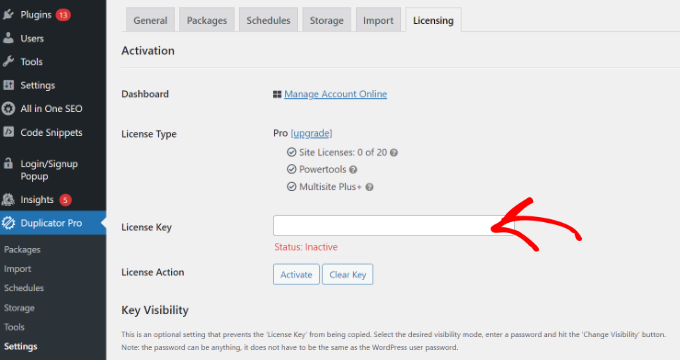
Next, you’ll need to head to the Duplicator Pro » Packages page from the WordPress dashboard.
From here, simply click the ‘Create New’ button in the top corner.

On the next screen, you will need to enter a name for your backup.
This will help you find the package when you need to restore a website.
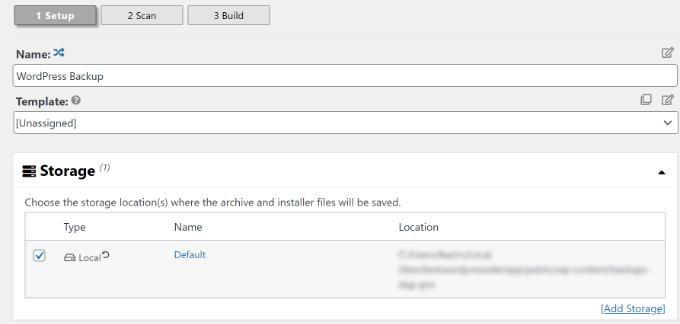
Under the Storage section, you can add another storage location for your package. The plugin will use the default location to save your backup files.
For this tutorial, we will use the default location. However, you can click the ‘Add Storage’ link and add a new location like Dropbox or Google Drive.
You can now scroll down to the Archive section to customize your backup. For instance, the plugin lets you only backup the database, filter files, folders and extensions, and more.
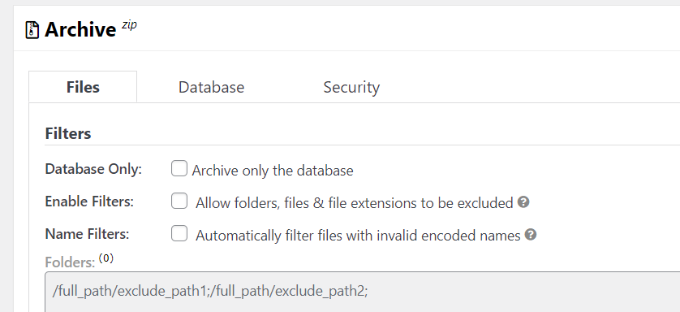
If you want a complete backup of your site, then we recommend keeping the default settings and don’t select anything under the Archive section.
Next, you can scroll down to the Installer section. These are optional settings that are filled in at the time of installing the backup.
You can simply click the ‘Next’ button and leave this section as it is.
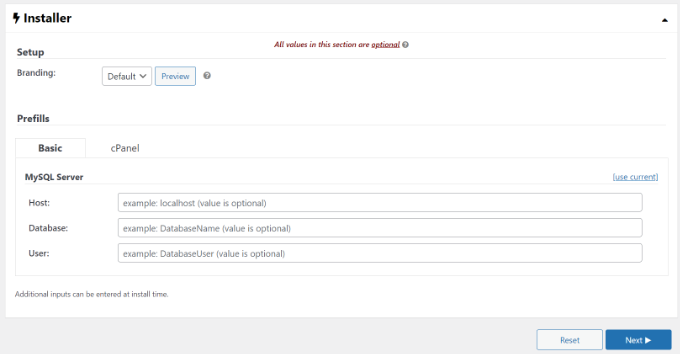
The plugin will now perform a scan and make sure everything is in order to create a backup of your site.
It will show a ‘Good’ evaluation if everything checks out or show a warning so you can quickly fix the issue before backing up the website.
Next, you can click the ‘Build’ button at the bottom.
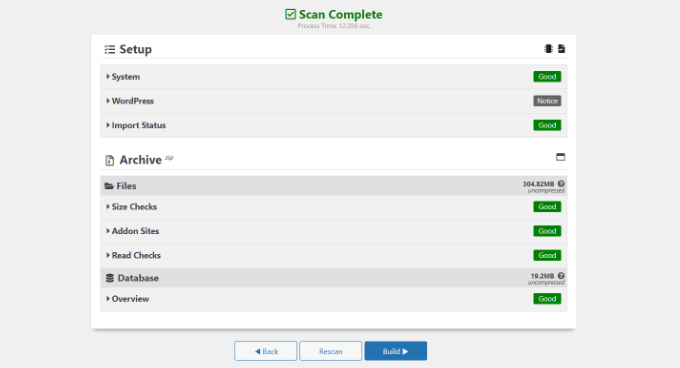
Duplicator will now start building a package.
Once it’s done, you can go to Duplicator Pro » Packages from your dashboard to view the backup.

Go ahead and click the ‘Download’ option and then select the ‘Both Files’ option.
This will download the zip file and the installer file onto your computer. You can then use these files as backup and easily restore your site in case of a cyberattack or a critical error.
Create a Recovery Point to Restore Your Website
Another advantage of using Duplicator is that it lets you set up a recovery point for your website. Recovery points help restore your backup if there is a massive website failure. This way, you can easily return to the last functioning version of your website.
To start, you can go to Duplicator Pro » Packages from your WordPress admin panel and click the arrow in the corner to expand the package details.

After that, simply click the ‘Recovery Point’ option.
A new window will now open. Go ahead and click the ‘Set Recovery Point’ option.
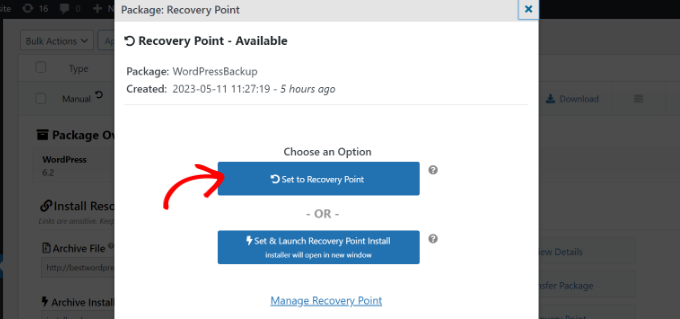
Next, you will need to click the recovery arrow icon to copy the recovery URL.
You can save this URL in a secure location and use it to easily restore your site in case of a failure or security vulnerability.

All you have to do is enter the recovery URL in the browser. This will automatically launch the recovery wizard. You can then follow the steps to restore your site from the backup.
Automatically Scheduling WordPress Website Backups
With Duplicator Pro, you can also automatically schedule backups for your website. This way, you will always have the latest website backup to work with. Plus, it helps save time as you don’t have to manually create a backup.
To start, you’ll need to go to Duplicator Pro » Schedules from the WordPress dashboard and click the ‘Add New’ button.
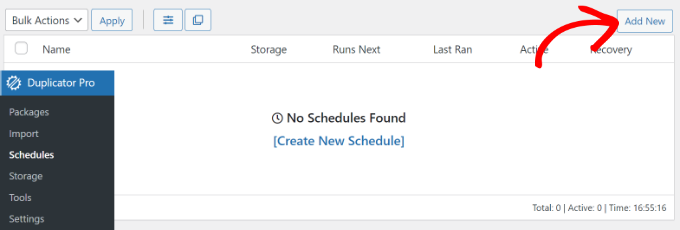
After that, you can enter a name for your backup schedule.
The plugin will also let you select a package template, where you get to customize your backup and choose which files to back up. If you want a full backup, then we recommend leaving the package template setting to default.

Next, you can scroll down and select the storage location for your scheduled backups. The plugin will use the default location, but you can add another location, like Dropbox, OneDrive, or Google Drive.
There is also an option to select the frequency of backups. For instance, you can set up automatic backups on an hourly, daily, weekly, or monthly basis. We’ve set the backup repeats to weekly for this tutorial.

After that, you can select a start time for your backup.
You’ll also need to ensure that the ‘Enable This Schedule’ checkbox is selected.
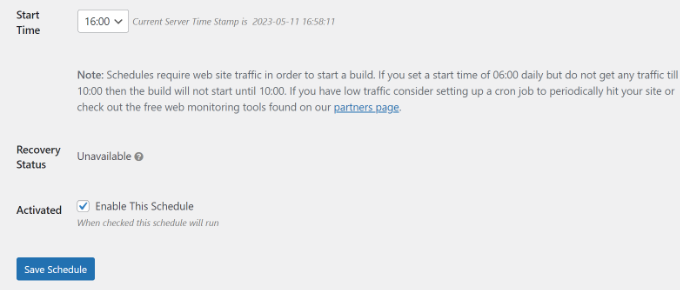
Duplicator will now automatically back up your WordPress site on the set day and time. This way, you’ll have a fresh backup to restore if anything goes wrong.
Method 2: Manually Backup a WordPress Site Using cPanel
You can also manually back up your WordPress website by using the cPanel of your WordPress hosting service.
For this tutorial, we will be using Bluehost. Do note that the settings may vary depending on the hosting service you’re using.
First, you’ll need to log in to the cPanel of your hosting provider. In Bluehost, you can find it under your site’s Advanced settings.
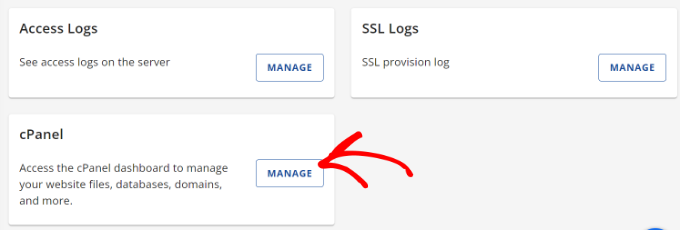
Once the cPanel opens, go to the Files section.
Then click the File Manager option.
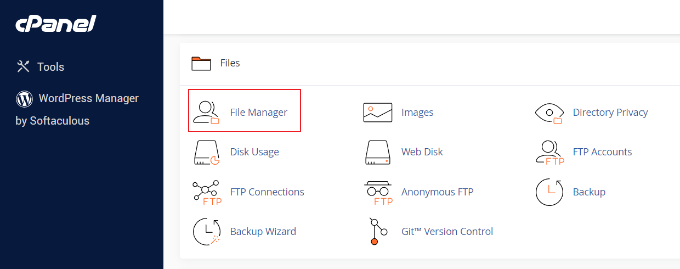
In a new tab or window, the file manager will now open.
Next, you need to select the public_html folder from the menu on the left and click the ‘+’ button to expand it.
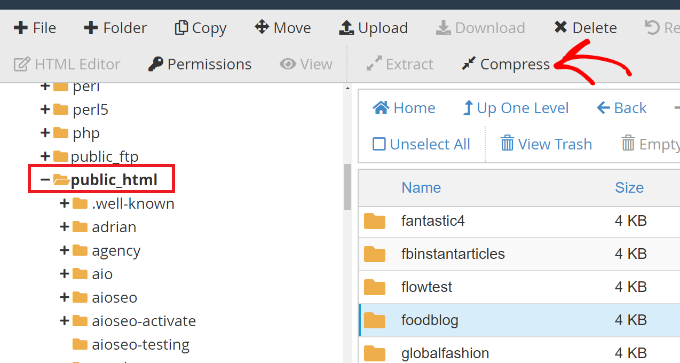
From here, simply select the folder with your website name and click the ‘Compress’ option at the top.
A new window will now pop up. Go ahead and select the ‘ Zip Archive’ option and click the ‘Compress Files’ button.

Your website files now start to compress into a zip file.
The hosting service will also show a compression result. You can simply click the ‘Close’ button.
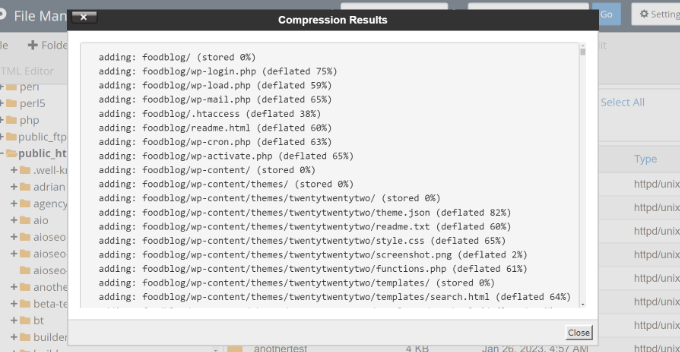
Next, you’ll need to select the zip file that you just created. It will be located in the public_html folder.
After selecting the file, simply click the ‘Download’ option at the top.

Next, you can save the compression file in a secure location.
Now, whenever your site goes down due to an error or security issues, you can use the compressed file as a backup and easily restore your content.
Method 3: Manually Backup WordPress Databases
Using your WordPress hosting services’ cPanel, you can also back up different WordPress databases. However, this is a time-consuming process because you’ll need to import multiple tables manually.
First, you will need to log in to the cPanel of your hosting service. We will be using Bluehost for this tutorial.
Next, head to the cPanel from your site’s settings. From here, simply click the ‘phpMyAdmin’ option.
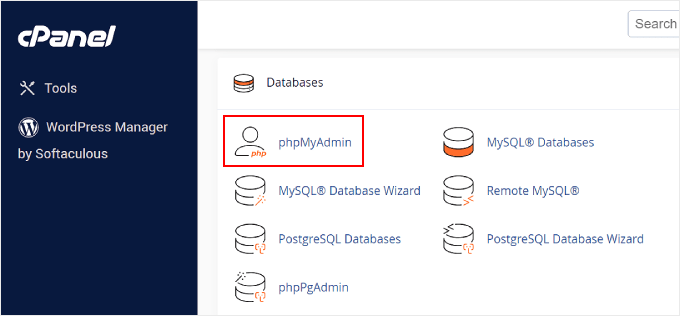
Once the phpMyAdmin opens, you can select a database from the menu on your left.
After that, simply select the tables you’d like to back up and click the ‘Export’ button at the top.
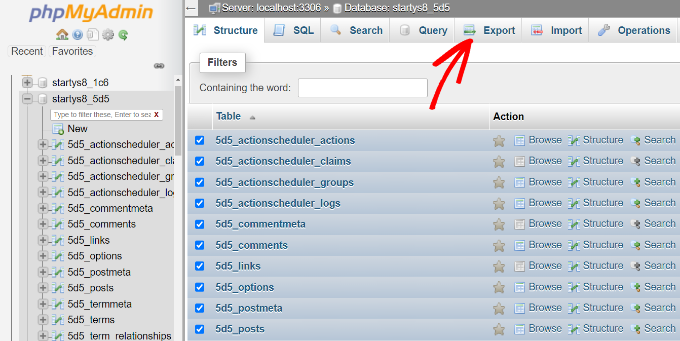
On the next screen, you can keep the ‘Export method’ as Quick. For the ‘Format’, you’d want to select SQL.
Once that’s done, go ahead and click the ‘Go’ button.
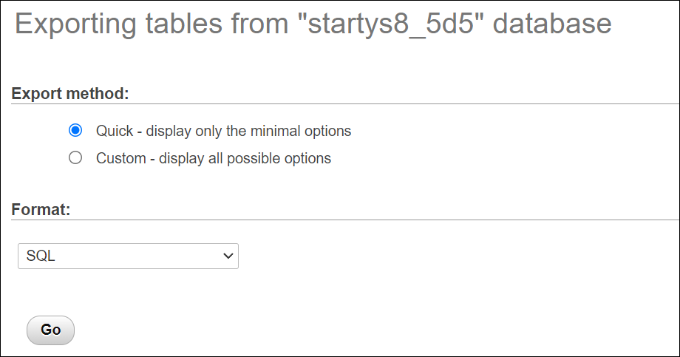
You can now save the SQL file on your computer in a secure location as a backup.
To restore a database, you’ll just need to import the SQL file into the phpMyAdmin panel.
Method 4: Manually Backup a WordPress Site Using FTP
If you don’t want to use a backup plugin or access the cPanel, then you can back up a WordPress site using an FTP client.
There are many FTP clients you can use for Mac and Windows. For this tutorial, we will use FileZilla.
First, you’ll need to connect to your site using the FTP software. You can see our guide on what is FTP and how to use it for more details.
Once you’re connected, simply head to the root directory of your website from the panel on your right. This is where you’ll find folders like wp-content, wp-admin, and other important files like wp-config and .htaccess.
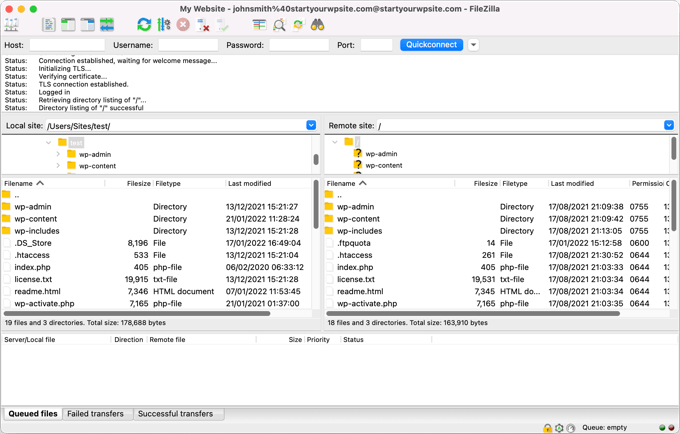
Next, you can right-click any folder or file you want to back up.
After that, simply click the ‘Download’ option.
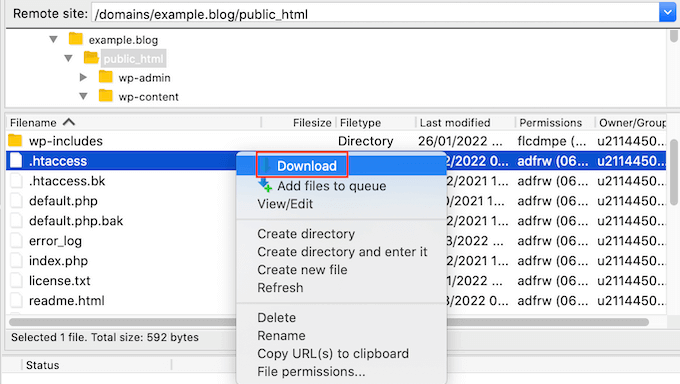
You can save the files and folders from a live website to your local host or computer as backups.
This way, you can easily recover your website by uploading the saved files using the FTP client.
Restoring a WordPress Site from Backup
Now that you’ve created a WordPress site backup, the next step is to restore it in case you encounter a critical error or your site is compromised.
First, you’ll need to clean your site and delete all the WordPress files. You can do that by connecting an FTP client and removing all the folders and files. After that, you will need to install WordPress again and log in to your site.
Next, you are ready to restore your WordPress backups.
If you are using the Duplicator Pro plugin, then it is very easy to upload the backup package. Simply head to Duplicator Pro » Import from your WordPress dashboard and drag and drop the package file.
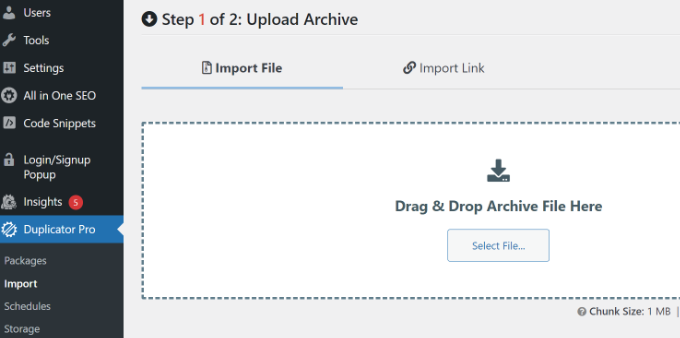
From here, simply follow the steps in the import wizard to recover your website. You can see our step-by-step guide on how to restore WordPress from a backup to learn more.
We hope this article helped you learn how to back up your WordPress site. You may also want to see our guide on WordPress security and the most common WordPress errors and how to fix them.
If you liked this article, then please subscribe to our YouTube Channel for WordPress video tutorials. You can also find us on Twitter and Facebook.





Syed Balkhi says
Hey WPBeginner readers,
Did you know you can win exciting prizes by commenting on WPBeginner?
Every month, our top blog commenters will win HUGE rewards, including premium WordPress plugin licenses and cash prizes.
You can get more details about the contest from here.
Start sharing your thoughts below to stand a chance to win!
Absalom Singagwari says
site backups are a critical function of any website. Its critical that one uses a reliable and easy to use method to backup their website because over and above the backing up, there is need to ensure the backup actually works, backup integrity as some call it. In my view, the best way to backup would be to use a reliable plugin that does all the dirty work for you. Its also critical to automate the process so that even when you forget, you are able to backup the site even when you are away!
THANKGOD JONATHAN says
These methods such as plugins, manual backups, and cloud storage services are really good options.
However, for me, I refer the plugin method and then automat it with Gdrive.
Mrteesurez says
Thanks for this post, it really helpful to saves years of hard work.
But, do backup using Cpanel included the media files like images or audio in the backed up files ??
Is exporting contents just from setting > tool > export can be considered as backup ??
WPBeginner Support says
The cPanel backup would include the files in your media folder but using tools>Export would not backup the media files as that would store where to grab the files from and not the files themselves.
Admin
Mrteesurez says
“as that would store where to grab the files from and not the files themselves”
What do you mean ??
because I have exported media files from a site and imported them into another and it worked well and showed those media files.
WPBeginner Support says
The export file would point to where on the old site your new site would be able to download the files, the export file does not include the media files themselves.
Ralph says
Thank you for this guide about such an important thing. Lack of backup can destroy years of work. Everybody should do backups!
Can this Duplicator plugin save and send the backup of my site to Google Drive automatically?
WPBeginner Support says
You can set up an automatic backup with the plugin
Admin
Jiří Vaněk says
Yes, and it works like magic. I’ve been using Duplicator for several months, and you can set up either manual or automatic backups to Google Drive. In the first step, you just need to link Google Drive with Duplicator, or rather with your website, but the process is really very simple. Then, on Google Drive, you select the folder where Duplicator will place the backups, either manually or automatically, as you set it up. You can also set the maximum number of backups that will be stored on the drive. As a bonus, you get weekly email reports about the backups.
Jiří Vaněk says
Great! I’ve always been used to manually backing up data—downloading data via FTP, creating a MySQL dump, and storing it all somewhere on the cloud. The older I get and the more websites I manage, the more I consider it fantastic to automate this task and reduce the chance of human error. There’s nothing worse than something breaking and not having a backup.
Ahmed Omar says
thank you for this post about this important part.
but here you explained about cPanel of blue host, is it the same on site ground.
and if there an option to back up the site regularly?
WPBeginner Support says
SiteGround has a different interface than BlueHost but should still give access to a file manager. Plugins and some hosting providers have tools for scheduling backups to automate it for you.
Admin
Moinuddin waheed says
I have used updraft plus for back up of almost all my websites and found it very easy and smooth.
This plugin takes care all of the things that needs to be taken into consideration.
The interface is beginners friendly and anyone can use it with ease.
I have not used duplicator so far but will give it a try in the future.
Linda Rogers says
Your restoration piece seems to assume that the WP installation is still accessible. I had a site hacked and the installation was no longer accessible. After deleting the hacked site and doing a new WordPress install. I couldn’t restore the site from either my Duplicator or Updraft backups. I think that was because I had a new database. Hopefully this never happens again but, what about that situation.
WPBeginner Support says
This article is for backing up your site, for restoring your WordPress site you would want to follow our guide below for restoring a site from a backup.
https://www.wpbeginner.com/beginners-guide/beginners-guide-how-to-restore-wordpress-from-backup/
Admin